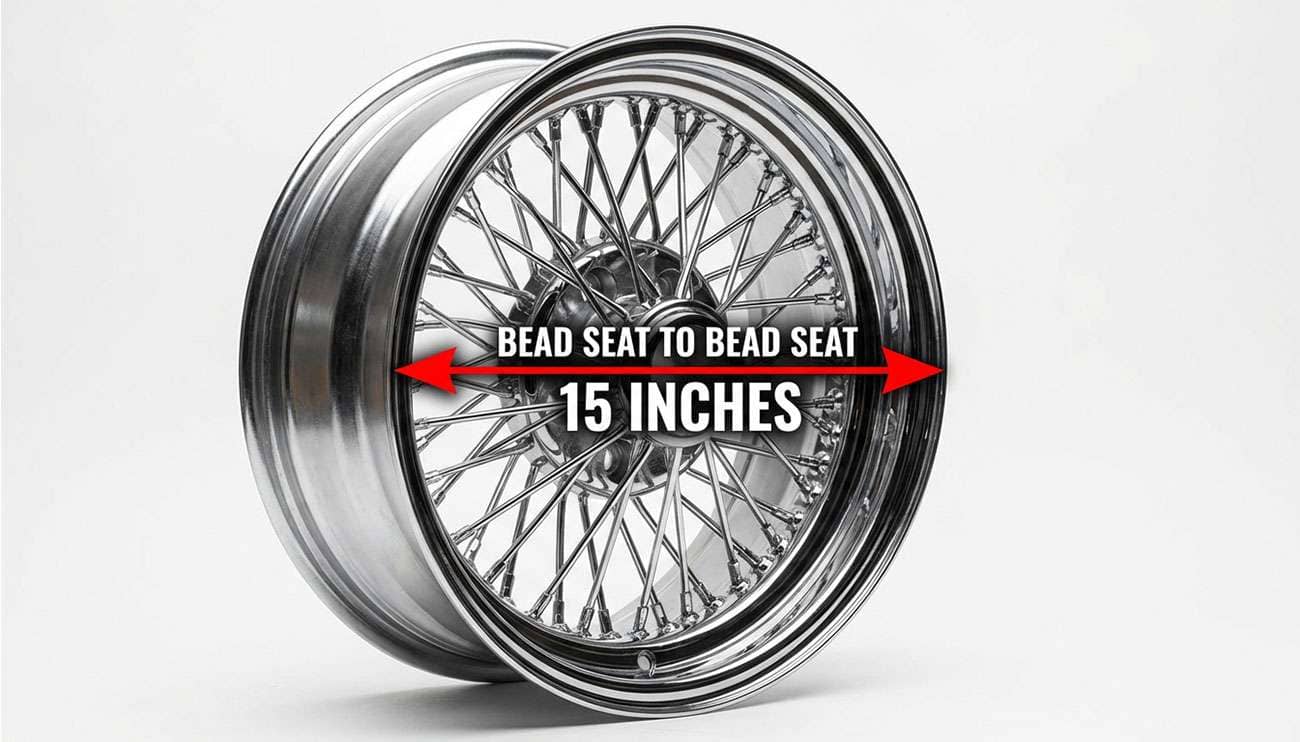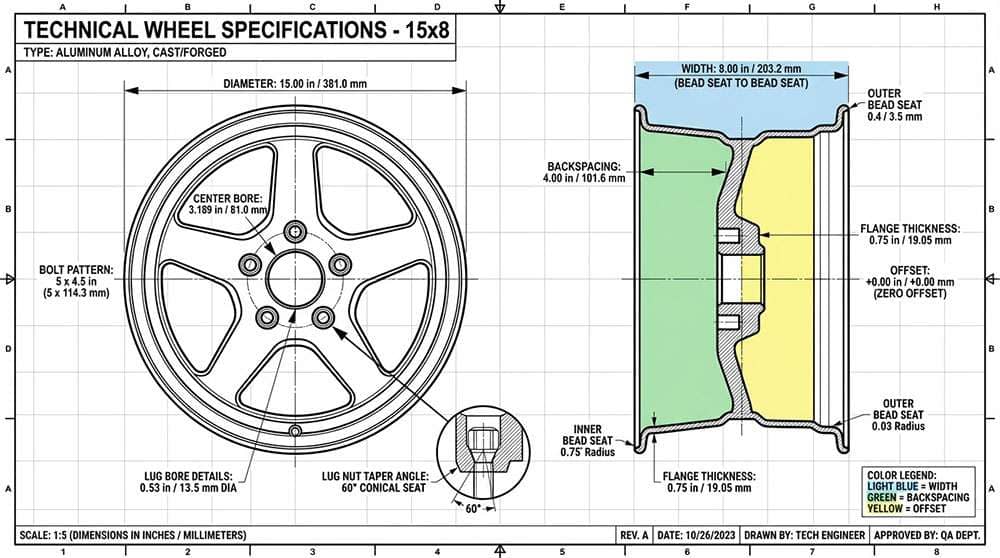
A 15x8 wheel size means the wheel measures 15 inches in diameter and 8 inches in width. The first number (15) represents the diameter of the wheel, while the second number (8) indicates the width. Both measurements are taken in inches using industry-standard methods that ensure proper fitment with your vehicle.
The diameter measurement spans from one side of the wheel to the opposite side, passing through the center point. You can find this dimension listed as part of your tire size on the sidewall or inside your driver's door frame. The width measurement is taken at the bead seats - the specific areas where your tire seals against the wheel. This measurement focuses on the functional sealing area, not the outer lip edges where the tire doesn't actually contact the wheel.
Custom wheels in 15x8 size offer excellent opportunities for both style enhancement and performance improvement. The 8-inch width creates a larger contact patch between your tire and the road surface, which directly affects traction, handling, and overall stability. Wider wheels like these 8-inch models can support larger tires than narrower options, potentially boosting grip during cornering and high-speed driving.
Factory wheels are engineered to work with your vehicle's suspension geometry, gear ratios, and body clearances. When selecting aftermarket 15x8 wheels, wheel offset becomes essential - this measurement determines how the wheel and tire assembly sits within your wheel well. Proper fitment also requires matching the hub size, center bore, and bolt pattern to your specific vehicle. Most vehicles use 4-, 5-, 6-, or 8-lug patterns, which helps narrow down your wheel choices.
Before choosing 15x8 wheels, consider how wheel width relates to tire width for optimal performance. While an 8-inch width provides more tire options compared to narrower wheels, successful fitment depends on your vehicle's specifications, suspension setup, and driving needs.

When you're shopping for wheels, understanding wheel size notation can make the difference between a perfect fit and costly mistakes. The 15x8 designation tells a specific story about your wheel's dimensions that directly impacts how it performs on your vehicle.
The second number in 15x8 represents your wheel's width measured in inches. This measurement is taken where it matters most—across the barrel of the wheel where your tire actually mounts. Here's what many people get wrong: width is measured from one bead seat to the other, not from the outer lip edges. Those bead seats are the critical areas where your tire creates its seal against the wheel.
An 8-inch width puts you right in the sweet spot of wheel sizing. Most wheels range from 6 to 14 inches wide, so you're getting a solid balance between stability and weight. This width gives you flexibility in tire selection too. An 8-inch wheel can effectively handle tires with tread widths around 8.2 inches, like popular 225/45-15 sizes.
The first number tells you everything about diameter—15 inches in this case. This measurement runs across the wheel face from one bead seat to the opposite side. Your tire size must match this exactly. A 15-inch wheel requires a 15-inch tire, period.
Wheel diameters typically run from 13 to 24 inches, with some specialized applications going larger. You can usually find this information stamped on the back of your wheel, often on one of the spokes.
Size alone doesn't guarantee proper fitment. You need to understand two additional specifications that can make or break your wheel selection. The bolt pattern uses two numbers—first, how many bolt holes your wheel has, then the diameter of the circle those holes form. When you see "4-100," that means 4 lug holes arranged in a 100mm diameter circle.
Offset measures the distance in millimeters from your wheel's mounting surface to its centerline. This can be positive, zero, or negative. Positive offset pushes the mounting face toward the front of the wheel, negative offset moves it toward the back, and zero offset centers it perfectly. Getting offset wrong means your wheels and tires could rub against brakes, fenders, or suspension components.
The 8-inch width changes how your vehicle handles, rides, and looks. These changes go beyond simple appearance upgrades.
Wider wheels deliver superior cornering grip. Testing shows vehicles equipped with wider wheels gain approximately half a second in lap times due to increased grip throughout corners. The 8-inch width provides more tire contact with the road surface, improving traction during aggressive driving.
However, this performance boost comes with compromises. Wider wheels with low-profile tires transmit more road impacts through the suspension system, resulting in a firmer ride. The reduced sidewall height acts as less cushioning between the road and vehicle, causing drivers to feel more road imperfections. Your daily commute becomes less comfortable, but your weekend canyon runs improve dramatically.
The 15x8 dimensions demand attention to wheel offset and tire size selection. Wider wheels increase unsprung weight (weight not supported by the suspension), potentially reducing responsiveness in cornering and steering. This additional rotating mass affects how quickly your vehicle responds to steering inputs.
Wheel offset significantly affects clearance, with an offset that's too low causing tires to extend beyond fenders. Incorrect fitment may cause tires to rub against fenders during turning or suspension compression. Proper measurement prevents costly mistakes and potential safety hazards.
The wider footprint creates a more aggressive appearance compared to narrower options. Many vehicle owners choose 15x8 wheels specifically for this enhanced stance. The combination of wheel size and offset directly influences how the wheels sit within the fenders, affecting overall vehicle appearance.
Proper wheel selection balances aesthetic goals with practical fitment requirements. The visual impact often justifies the performance trade-offs for enthusiasts seeking a distinctive look.
Larger, heavier wheels increase rolling resistance, forcing the engine to work harder. Research demonstrates upsizing wheels can cause a 4-10% reduction in fuel economy. This decreased efficiency results from greater rotational mass and increased friction between tires and road surface.
Highway driving at sustained speeds may partially offset this disadvantage. The mpg penalty becomes most noticeable during city driving with frequent acceleration and braking cycles.
The difference between 15x8 and 15x7 wheels comes down to that crucial inch of width. This single inch creates significant changes in tire compatibility, performance characteristics, and vehicle appearance.
Tire Fitment Capabilities
15x7 wheels work well with tires up to 31x10.50 in size, making them suitable for many standard applications. However, 15x8 wheels provide the support needed for larger tires, particularly 33x12.50 and above. This extra width becomes essential when you're running bigger, more aggressive tire sizes.
Performance Differences
15x7 wheels typically deliver a smoother ride experience, while 15x8 wheels offer enhanced cornering capabilities through their wider contact patch. The 8-inch width proves particularly advantageous for off-road applications—these wheels keep tires more securely seated during air-down situations commonly used on rough terrain.
Fitment Considerations
Backspacing becomes critical when choosing between these sizes. Improper backspacing can cause tires to rub against suspension components or extend too far beyond your fenders. The ideal backspacing varies depending on your specific vehicle design, regardless of whether you choose 7-inch or 8-inch width.
Staggered Setups
Some enthusiasts run staggered configurations with 15x7 wheels in front and 15x8 wheels in the rear. This setup creates an appealing stance while potentially improving handling through increased rear grip.
Making the Right Choice
Both sizes use the same 15-inch diameter, ensuring compatibility with 15-inch tires. However, the width difference affects which tire sizes perform optimally on each wheel. Proper wheel-to-tire matching ensures you get maximum performance from your setup.
Understanding wheel dimensions is crucial for proper vehicle fitment and performance optimization. Here are the essential insights about 15x8 wheels:
• 15x8 means 15-inch diameter and 8-inch width - The first number indicates wheel diameter, the second represents width measured at bead seats where tires mount.
• Wider wheels improve cornering but reduce ride comfort - 8-inch width provides better grip and handling but transmits more road impacts through stiffer sidewalls.
• Proper fitment requires matching bolt pattern and offset - Beyond size, wheels must align with your vehicle's hub specifications to prevent rubbing against brakes or suspension components.
• Larger wheels decrease fuel efficiency by 4-10% - Increased rotational mass and rolling resistance force the engine to work harder, reducing overall fuel economy.
• 15x8 wheels accommodate larger tires than 15x7 options - The extra inch of width supports bigger tire sizes (33x12.50+) and keeps tires better seated during off-road air-down situations.
When selecting aftermarket wheels, always verify compatibility with your vehicle's suspension geometry, clearance requirements, and intended driving conditions to ensure optimal performance and safety.
A 15x8 wheel size indicates a wheel with a 15-inch diameter and 8-inch width. The first number (15) represents the wheel's diameter, while the second number (8) denotes its width, both measured in inches.
A 15x8 wheel can improve cornering grip and handling due to its wider footprint. However, it may result in a firmer ride as it transmits more road impacts. It can also impact fuel efficiency, potentially reducing it by 4-10% due to increased rolling resistance.
15x8 wheels can accommodate larger tires compared to narrower options. They are suitable for tires sizes like 33x12.50 and above. The 8-inch width provides better support for wider tires, making them advantageous for off-road applications.
The main difference is the width. 15x8 wheels offer better cornering capabilities and can accommodate larger tires, while 15x7 wheels generally provide a smoother ride. The 15x8 configuration is often preferred for its wider stance and more aggressive look.
When fitting 15x8 wheels, it's crucial to consider the bolt pattern, offset, and backspacing. These factors affect wheel alignment within the wheel well and clearance with suspension components. It's also important to ensure the wheels are compatible with your vehicle's specifications and intended use.